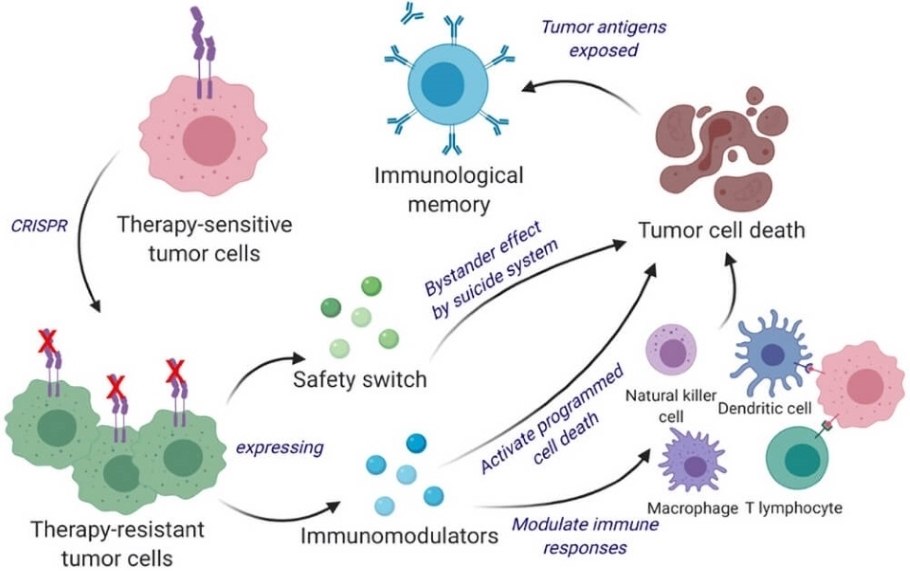Cancer Vaccine Kills and Prevents Brain Cancer
Author: Brigham and Women's Hospital
Published: 2023/01/06 - Updated: 2023/06/28
Publication Details: Peer-Reviewed, Medical Research
Category Topic: CRISPR Research News - Academic Publications
Page Content: Synopsis - Introduction - Main
Synopsis: Engineering living tumor cells using the gene-editing tool CRISPR-Cas9 and repurposing them to release tumor cell-killing agent. Like homing pigeons returning to roost, living tumor cells will travel long distances across the brain to return to the site of their fellow tumor cells.
Introduction
Bifunctional Cancer Cell-Based Vaccine Concomitantly Drives Direct Tumor Killing and Antitumor Immunity - Science Translational Medicine.
Scientists are harnessing a new way to turn cancer cells into potent, anti-cancer agents. In the latest work from the lab of Khalid Shah, MS, Ph.D., at Brigham and Women's Hospital, a founding member of the Mass General Brigham healthcare system, investigators have developed a new cell therapy approach to eliminate established tumors and induce long-term immunity, training the immune system so that it can prevent cancer from recurring. With promising results, the team tested their dual-action, cancer-killing vaccine in an advanced mouse model of the deadly brain cancer, glioblastoma. Findings are published in Science Translational Medicine.
Main Content
"Our team has pursued a simple idea: to take cancer cells and transform them into cancer killers and vaccines," said corresponding author Khalid Shah, MS, Ph.D., director of the Center for Stem Cell and Translational Immunotherapy (CSTI) and the vice chair of research in the Department of Neurosurgery at the Brigham and faculty at Harvard Medical School and Harvard Stem Cell Institute (HSCI). "Using gene engineering, we are repurposing cancer cells to develop a therapeutic that kills tumor cells and stimulates the immune system to destroy primary tumors and prevent cancer."
Cancer vaccines are an active area of research for many labs, but Shah and his colleagues' approach is distinct. Instead of using inactivated tumor cells, the team repurposes living tumor cells, which possess an unusual feature. Like homing pigeons returning to roost, living tumor cells will travel long distances across the brain to return to the site of their fellow tumor cells. Taking advantage of this unique property, Shah's team engineered living tumor cells using the gene-editing tool CRISPR-Cas9 and repurposed them to release tumor cell killing agent.
In addition, the engineered tumor cells were designed to express factors that would make them easy for the immune system to spot, tag, and remember, priming the immune system for a long-term anti-tumor response.
The team tested their repurposed CRISPR-enhanced and reverse-engineered therapeutic tumor cells (ThTC) in different mice strains, including the one that bore bone marrow, liver, and thymus cells derived from humans, mimicking the human immune microenvironment.

Shah's team also built a two-layered safety switch into the cancer cell, which, when activated, eradicates ThTCs if needed. This dual-action cell therapy was safe, applicable, and efficacious in these models, suggesting a roadmap toward therapy. While further testing and development are needed, Shah's team chose this model and used human cells to smooth the path of translating their findings for patient settings.
"Throughout all of the work that we do in the Center, even when it is highly technical, we never lose sight of the patient," said Shah. "Our goal is to take an innovative but translatable approach to develop a therapeutic, cancer-killing vaccine that ultimately will have a lasting impact in medicine."
Shah and colleagues note that this therapeutic strategy applies to a wider range of solid tumors and that further investigations of its applications are warranted.
Disclosures:
Shah owns equity and is a member of the Board of Directors of AMASA Therapeutics, a company developing stem cell-based therapies for cancer.
Funding:
This work was supported by the National Institutes of Health (grant R01-NS121096).
Paper cited:
Chen KS et al. "Bifunctional cancer cell-based vaccine concomitantly drives direct tumor killing and antitumor immunity" Science Translational Medicine DOI: 10.1126/scitranslmed.abo4778
Attribution/Source(s): This peer reviewed publication was selected for publishing by the editors of Disabled World (DW) due to its relevance to the disability community. Originally authored by Brigham and Women's Hospital and published on 2023/01/06, this content may have been edited for style, clarity, or brevity.